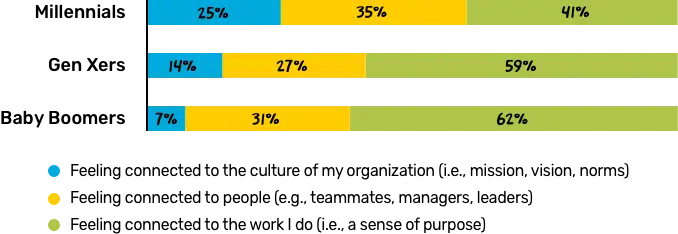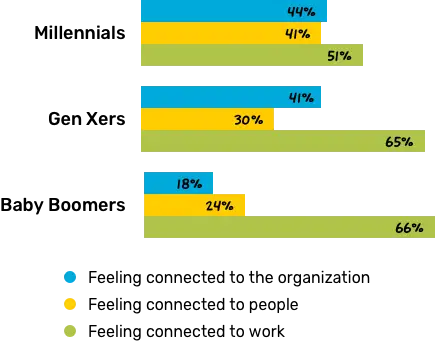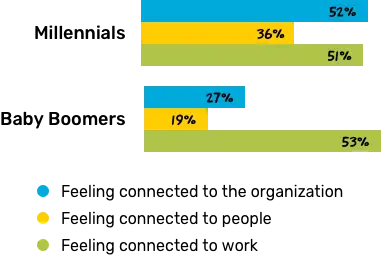Report
From Baby Boomers to Gen Z: Adapting government employee connection strategies for today’s workforce
Why one-size-fits-all connection approaches don’t work

Related services and insights
Talent5 steps to improve employee connection and boost organizational performance
An Eagle Hill Consulting survey of government employees reveals striking generational differences in how government employee connection impacts job satisfaction, retention, and performance. Given the workforce’s shifting demographics, agencies should cultivate connections in different ways to maximize the potential of their current and future workforces—and deliver business results.
Profound demographic changes are happening across the government workforce. While Baby Boomers made up most of this workforce for many years, this is no longer the case. Most employees are now younger people. In fact, Gen Z (1%), Millennials (26%), and Gen Xers (47%) together make up nearly three-quarters of the federal workforce today, according to the Federal Employee Viewpoint Survey.
Given the attrition trends reported in this same survey, we expect this younger workforce to grow quickly. For example, just over one-quarter (28%) of federal employees plan to retire in the next five years. Building connections among the employees who remain will strengthen critical building blocks of overall agency performance including seamless knowledge transfer, strong succession plans, and an engaged workforce.
A major shift in government employee connection
To understand how the different aspects of connection drive employees’ overall work experience and job performance, we surveyed local, state, and federal government workers across the United States.
The survey results reveal a surprising shift in what drives a sense of connection for agency workers. While a sense of purpose (connection to work) is important to government employees’ overall work experience and performance, it’s not everything—especially for younger generations of government employees.
For many government employees, their relationships at work (connection to people) and how they feel about the culture (connection to organization) have just as much of an influence on retention, professional development, and customer service as connection to work does. This is notable given that government has long relied on employees’ sense of purpose (connection to work) to attract and retain talent. After all, government employees do “the people’s work,” helping to improve lives, communities, and society more broadly.

What is employee connection?
Employee connection is a sense of belonging in the workplace grounded in several aspects of employee experience:
- Connection to work: having a sense of satisfaction and purpose day-to-day
- Connection to people: developing relationships with peers, teams, managers, and leaders
- Connection to organization: feeling that personal values align with the culture, mission, values, and norms
The importance of generational differences
The multi-faceted nature of connection is especially true for younger generations of government employees. When it comes to overall work experience, a sense of purpose (connection to work) matters less to Millennials and Gen X employees than to their predecessors. At the same time, connection to organizational culture matters significantly more.
While the majority of Baby Boomers (62%) say that sense of purpose is the most important driver of their overall work experience, just 41% of Millennials say the same thing. Additionally, compared to Baby Boomers (7%), Gen Xers are twice as likely (14%) and Millennials are three times as likely (25%) to say that connection to organizational culture matters most to their overall work experience (Figure 1).
Figure 1: Connection to culture matters more to younger government employees than it does to their predecessors
Q: What matters most in your day-to-day work experience?

Source: Eagle Hill Consulting Employee Connection Survey 2023
Generational differences influencing government employee connection are evident in critical areas
Retention
For Millennials and Gen Xers, feeling connected to people and the organizational culture is just as impactful, if not more so, than feeling connected to work when deciding to stay or leave. Conversely, Baby Boomers say that connection to their work vastly outranks connection to people and connection to organizational culture when making the same decision (Figure 2).
Figure 2: Connection to people and organization matter more to younger government employees
Q: Which of the following impacts your decision to stay or leave an organization?

Source: Eagle Hill Consulting Employee Connection Survey 2023
Ability to do the job
Compared to Baby Boomers, Millennials and Gen Xers are more than twice as likely to report that feeling connected to the organizational culture impacts their ability to do their job (Figure 3).
Figure 3: Younger government employees are much more likely to cite connection to organization and people as drivers of job performance
Q: Which of the following impacts your ability to do your job?

Source: Eagle Hill Consulting Employee Connection Survey 2023
Professional and career development
When it comes to how government employee connection impacts career development, Millennials rank connection to organizational culture as the most important driver. It ranks above both feeling connected to the work itself and people. Millennials are also nearly twice as likely as Baby Boomers to cite connection to organizational culture and people as factors that impact their career development (Figure 4).
Figure 4: Millennials rank connection to their organization as most impactful to their career development
Q: Which of the following impacts your professional and career development?

Source: Eagle Hill Consulting Employee Connection Survey 2023
Customer service
Millennials and Gen Xers are more than twice as likely to cite connection to organizational culture as a driver of customer service than Baby Boomers are. Additionally, for Millennials—one quarter of the government workforce—connection to people (48%) has a greater impact on serving customers than connection to work (45%) does (Figure 5).
Interestingly, across generations, most federal government employees (69%) believe that improving organizational culture would do more to improve customer service in government than resource-intensive factors such as enhanced technology (54%) or more financial resources (45%).
Figure 5: Younger government employees are more than twice as likely to say connection to organization impacts customer service
Q: Which of the following impacts your ability to serve customers?

Source: Eagle Hill Consulting Employee Connection Survey 2023
The right investment in government employee connection
When looking for ways to maximize outcomes for employees and their mission, agency leaders should account for the generational shift in the government workforce—especially the fact that younger generations are more likely to rate connection to people and connection to organizational culture as performance drivers.
Government leaders can no longer assume that the power of the mission alone is enough to create a sense of connection for employees. While 63% of government workers say their organization is investing in connection, our survey findings suggest these investments might not be focused in the right areas.
The best investments address all aspects of feeling connected. Given the workforce environment—including how effectively the private sector competes for top talent—complacency is a risk for agencies. That’s why it’s time to foster the aspects of employee connection that have the most impact on performance for the majority of government employees.

Improving employee connection
Fostering connections to people and organizational culture in addition to work improves employee experience, customer service, and agency performance. Read our guide to learn the five steps to improve employee connections.
Methodology
The survey was conducted online by Ipsos the week of January 3-5, 2023. The survey included 547 adult respondents from a random sample of full- and part-time local, state, and federal government employees across the United States. The survey polled respondents to understand their feelings about employee connection as well as their views on what actions employers can take to create more employee connection in the workplace.

